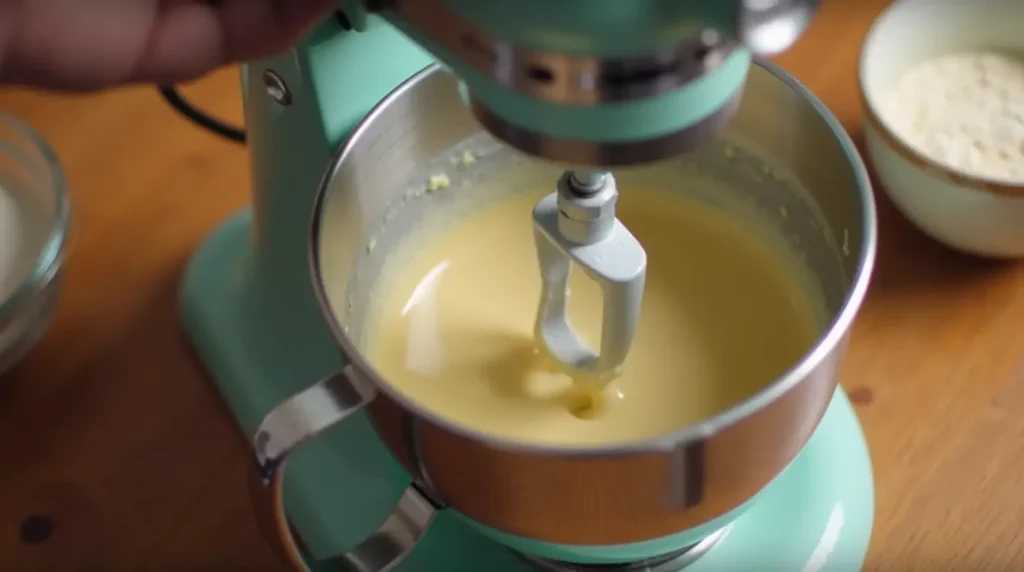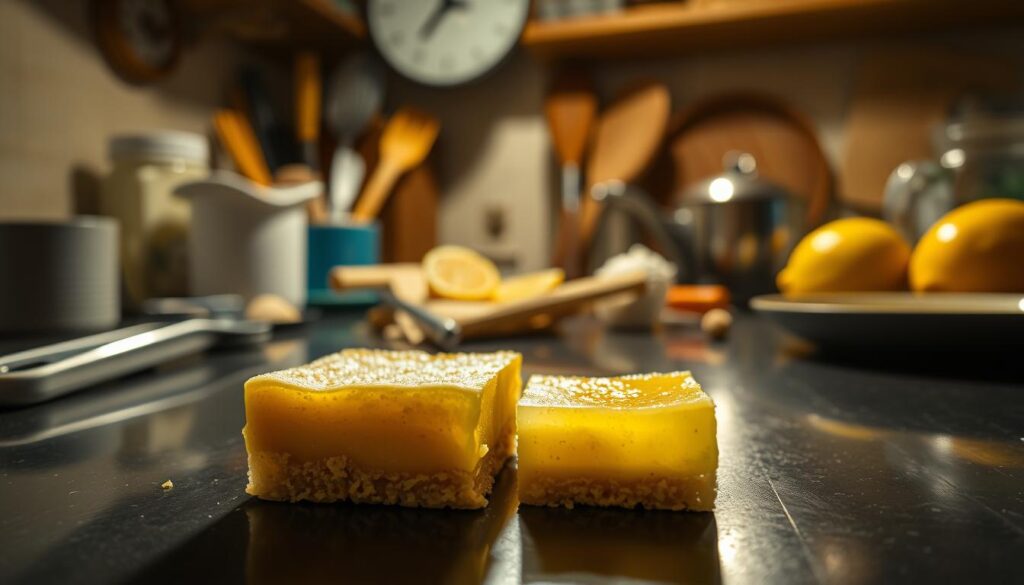Best Lemon Bars With Shortbread Crust

Imagine a dessert that’s the essence of spring and summer gatherings. It’s bright, tangy, and can’t be ignored. Homemade lemon bars are the perfect treat. They offer a delightful mix of sweet and tart flavors that will impress anyone.
These lemon dessert classics are a hit at any gathering. They’re surprisingly easy to make with ingredients you likely have at home. The shortbread crust is sturdy, and the lemon filling is vibrant. The powdered sugar on top adds elegance. Whether you’re an experienced baker or new to desserts, these lemon bars are a timeless favorite.
Table of Contents
The Perfect Balance of Sweet and Tangy
A perfect blend of sweet and tangy flavors is key to great lemon bars. Freshly squeezed lemon juice and grated lemon zest are crucial. They make the bars burst with citrus flavor, making them both vibrant and tasty.
The tangy lemon bars owe their unique taste to lots of lemons. The lemon juice’s acidity balances the richness of the shortbread crust. The lemon zest adds a citrusy burst, improving the taste.
When making classic lemon bars, finding the right balance is important. The sweetness of the crust and filling must match the tartness of the lemons. This balance makes the bars appealing to many.
What Makes the Best Lemon Bars?
Making the best lemon bars is an art that combines texture and flavor. It’s all about getting the right mix of both. You need to focus on the texture and the taste.
The Ideal Texture
The perfect delicious lemon bars have a crisp, buttery crust and a creamy lemon filling. Getting this right takes some effort. For the crust, adding a bit of cornstarch is key. It makes the crust both crispy and stable.
For the lemon filling, it’s important to keep it smooth and creamy. Use room temperature ingredients and avoid overmixing. This will help you get the right texture.
Flavor Profile
The best lemon bars have a sweet and tangy flavor. The lemon filling should be full of lemon taste but not too sour. The shortbread crust should be rich and buttery.
Using top-notch ingredients like fresh lemons and real butter is crucial. A good lemon bar recipe will make sure the flavors work well together. This creates a dessert that tastes amazing.
Essential Ingredients for Classic Lemon Bars
A great lemon bar starts with the right ingredients. We’ll go over what you need for a classic recipe. You’ll focus on two key parts: the shortbread crust and the lemon filling.
For the Shortbread Crust
The shortbread crust is key for lemon bars. It needs just a few ingredients, but quality matters. You’ll need:
- 2 cups of flour
- 1/2 cup of powdered sugar
- 1 cup of cold butter
Using cold butter is crucial for a crumbly texture. The powdered sugar adds sweetness and softness to the crust.
For the Lemon Filling
The lemon filling makes lemon squares taste unique. You’ll need:
| Ingredient | Quantity |
|---|---|
| Eggs | 4 |
| Sugar | 2 cups |
| Fresh lemon juice | 1/3 cup |
| Baking powder | 1/2 teaspoon |
| Salt | 1/4 teaspoon |
| Flour | 1/4 cup |
The lemon juice must be fresh for the best taste. Eggs give structure, and sugar balances the tartness of the lemons.
Equipment You’ll Need
Before you start making homemade lemon bars, you need the right tools. The right equipment makes the process easier. It also helps your lemon bar recipe turn out just right.
Baking Tools
You’ll need a 9×13 inch pan to bake your recipe. You’ll also need a mixing bowl, a pastry blender, and a stand mixer or a medium-sized mixing bowl. The pastry blender is key for making the shortbread crust.
Measuring Essentials
Getting the measurements right is crucial for a great lemon bar recipe. You’ll need measuring cups and spoons. Digital scales can also help with precision.
| Tool | Purpose |
|---|---|
| 9×13 inch pan | Baking the lemon bars |
| Mixing bowl | Mixing the crust and filling |
| Pastry blender | Creating the shortbread crust |
| Measuring cups and spoons | Measuring ingredients accurately |
Step-by-Step: Preparing the Perfect Shortbread Crust
To make exceptional lemon bars, start with a perfectly baked shortbread crust. This layer is key for the dessert’s texture and flavor.
Mixing the Dough
Start by chopping butter into small pieces for even mixing. In a medium bowl, mix flour and powdered sugar. Add the butter and use a pastry blender until it’s coarse crumbs.
This step is crucial for a crumbly yet cohesive crust. As Julia Child said, “The only time to eat diet food is while you’re waiting for the steak to cook.” Here, the “steak” is your shortbread crust.
Press the mixture into a 9×13 pan sprayed with cooking spray. Make sure it’s evenly spread to avoid thin spots.
Pre-Baking the Crust
Pre-baking the crust is key to a lightly golden, set base. This step prevents sogginess and ensures a sturdy base for your lemon bars. Bake at 350°F for about 20 minutes or until lightly golden.
Common Crust Mistakes to Avoid
One common mistake is not chilling the crust before baking. This can cause it to spread too much or lose shape. Another mistake is overbaking, which makes the crust too dark or hard.
To avoid these, keep an eye on your crust while baking. Chilling it in the fridge for 10-15 minutes before baking helps it keep its shape.
By following these steps and avoiding common mistakes, you’ll make delicious lemon bars with shortbread crust that will impress anyone.
Step-by-Step: Creating the Luscious Lemon Filling
Your lemon squares’ success depends on the luscious lemon filling. This key part needs careful attention and finesse to get it just right.
Juicing and Zesting Techniques
To begin, juice and zest your lemons. Use a microplane grater for zesting, avoiding the white pith. For juicing, a manual or electric juicer works best. Strain the juice to remove seeds or pulp.
Strive for a fresh, citrusy flavor in your lemon squares.
Mixing the Filling
With your lemon juice and zest ready, mix the filling. Mix the juice with eggs until well blended. In another bowl, whisk together sugar, baking powder, salt, and flour.
Slowly add these dry ingredients to your mixer, mixing until just combined. This should result in a smooth, creamy filling.

Achieving the Perfect Consistency
The filling’s consistency is crucial. It should be thick enough to hold its shape but still smooth and creamy. To check, gently tilt the mixing bowl.
If the filling barely moves, it’s ready. If not, add a bit more baking powder or let it rest for a short time. This care will make your lemon squares stand out.
By following these steps and tips, you’ll create an exceptional lemon squares recipe with a luscious lemon filling.
Baking Your Recipe to Perfection
Getting your Recipe just right takes precision and patience. You need to focus on the baking process. This ensures both the shortbread crust and the lemon filling are perfect.
Temperature and Timing
First, preheat your oven to the right temperature. For ina garten lemon bars, set it to 350 degrees. The shortbread crust needs 20 minutes in the oven.
After adding the lemon filling, bake for another 25 minutes. This is key to baking lemon bars. It makes sure the filling is set and the crust is golden.
Keep an eye on the timer to avoid mistakes. Adjust as needed based on your oven’s performance.
How to Tell When They’re Done
Figuring out when lemon bars are done can be tricky. Look for a few signs. The edges should be lightly golden, and the filling should be set.
You can check by gently jiggling the pan. If it’s still jiggly, it might need a few more minutes. Following a good lemon bars recipe and these tips will help you get it right.
By paying attention to these details, you’ll enjoy perfectly baked Desserts.
Cooling and Cutting Tips
After baking your recipe perfectly, cooling them is key. This step is vital for the right texture and easy cutting.
Proper Cooling Techniques
Let your lemon bars cool completely in the pan on a wire rack. This prevents cracking and ensures the filling sets right. Avoid cutting into the bars while they’re still warm, as it can make them break apart. To cool faster, put the pan in the fridge for about 30 minutes after it cools a bit at room temperature.
Clean-Cut Methods
For clean cuts, use a sharp knife and wipe it clean between cuts. Chilling the lemon bars in the fridge for at least 30 minutes before cutting helps. This makes cutting smooth and even. Here are more tips for cutting:
- Use a sharp, thin-bladed knife.
- Cut in a gentle sawing motion.
- Clean the knife between cuts to prevent sticking.
Troubleshooting Common Lemon Bar Problems
Making perfect lemon bars is more than just following a recipe. It’s also about solving common problems. Issues like a soggy crust, cracks, or an off balance of sweet and tart can happen to anyone.
Fixing a Soggy Crust
A soggy crust can mess up your lemon bars. To avoid this, use the right baking method. Line your pan with heavy-duty aluminum foil or parchment paper. This helps prevent the crust from getting soggy and makes it easier to remove.

Dealing with Cracks and Bubbles
Cracks and bubbles can make your lemon bars look bad. To prevent them, don’t overmix the filling. Also, baking at the right temperature and time is key. If cracks do show up, cutting the bars a bit bigger can help hide them.
Adjusting Sweetness and Tartness
The right mix of sweet and tart is key in lemon bars. If they’re too sweet, add a bit more lemon juice. If they’re too tart, a little more sugar can fix it. The goal is to make small changes to get it just right.
Delicious Variations of Traditional Lemon Bars
Looking to mix up the classic recipe? Try these tasty variations. They let you create unique flavors that will excite your taste buds.
Meyer Lemon Bars
Meyer lemon bars are sweeter and less acidic than traditional ones. They use Meyer lemons for a dessert that’s tangy yet sweet. This makes them great for those who like a milder lemon flavor.
Raspberry Lemon Bars
Raspberry lemon bars add a fruity and tart twist. The raspberry’s sweetness and lemon’s acidity mix for a wonderful taste. You can use fresh or frozen raspberries for a tasty change.
Coconut Lemon Bars
Adding coconut flakes or shredded coconut makes lemon bars richer and more flavorful. The coconut and lemon mix for a tropical dessert perfect for summer. Coconut cream can also make the filling creamier.
| Variation | Key Ingredient | Flavor Profile |
|---|---|---|
| Meyer Lemon Bars | Meyer Lemons | Sweeter, less acidic |
| Raspberry Lemon Bars | Raspberries | Fruity, tangy |
| Coconut Lemon Bars | Coconut flakes or shredded coconut | Tropical, rich texture |
Trying these variations lets you add your own twist to lemon bars. Whether you like Meyer lemons, raspberries, or coconut, there’s a tasty version for you.
Storage and Make-Ahead Tips
You can enjoy your lemon bars for days with simple storage tips. Storing them right keeps your homemade lemon bars fresh and tasty. They’ll stay as good as the day you baked them.
Refrigeration Guidelines
For a few days, keep your best lemon Desserts in a covered container in the fridge. They last up to 4 days. Make sure they’re tightly covered with plastic wrap or foil.
Freezing Instructions
Freezing is great for longer storage. Cut them into bars, freeze on parchment-lined baking sheets, and then store in airtight containers or bags. To thaw, let them sit at room temperature or refrigerate overnight. This is perfect for storing lemon bars for a long time.
Conclusion
Now you know how to make a tasty lemon dessert that will wow your loved ones. The secret to the best Desserts is using top-notch ingredients and following the steps we shared.
Learning to make the perfect shortbread crust and lemon filling is key. This way, you’ll get a mix of sweet and tangy in your lemon bars. It doesn’t matter if you’re new to baking or have been doing it for years. This classic treat is sure to be a hit.
With these tips, it’s time to try making lemon bars. Feel free to try new things like Meyer lemon or raspberry lemon bars. This way, you can make your own special version of this favorite dessert.
FAQ
What is the best way to store lemon bars?
Store lemon bars in an airtight container in the fridge for up to 5 days. You can also freeze them for up to 2 months.
Can I make lemon bars ahead of time?
Yes, you can make lemon bars ahead of time. Store them in the fridge or freezer until ready to serve.
How do I prevent a soggy crust when making lemon bars?
To avoid a soggy crust, pre-bake the shortbread until it’s lightly golden. Also, don’t overmix the dough.
What’s the best way to achieve a clean cut when cutting lemon bars?
For a clean cut, let the lemon bars cool completely. Use a sharp knife, wiping it clean between cuts.
Can I use a different type of citrus instead of lemons?
Yes, try using limes or oranges for unique flavors.
How do I adjust the sweetness and tartness of my lemon bars?
Adjust sweetness and tartness by changing sugar and lemon juice amounts to your liking.
What’s the best way to zest a lemon?
Use a fine grater or zester. Only grate the outer layer, avoiding the white pith.
Can I make Ina Garten’s lemon bars recipe?
Yes, follow Ina Garten’s instructions and use her specified ingredients.
How do I make a classic lemon bars recipe?
Prepare a shortbread crust and lemon filling. Bake until the filling is set.
What’s the best lemon bars recipe for a tangy dessert?
For tanginess, use high-quality lemon juice and zest. Adjust sugar to balance the flavor.
Can I make easy lemon bars with a shortbread crust?
Yes, use a simple recipe with pre-made shortbread or a straightforward crust recipe.
How do I make homemade lemon bars?
Prepare the shortbread crust and lemon filling from scratch. Use fresh ingredients and a reliable recipe.
How did you like the recipe?
There are no reviews yet. Be the first one to write one.
